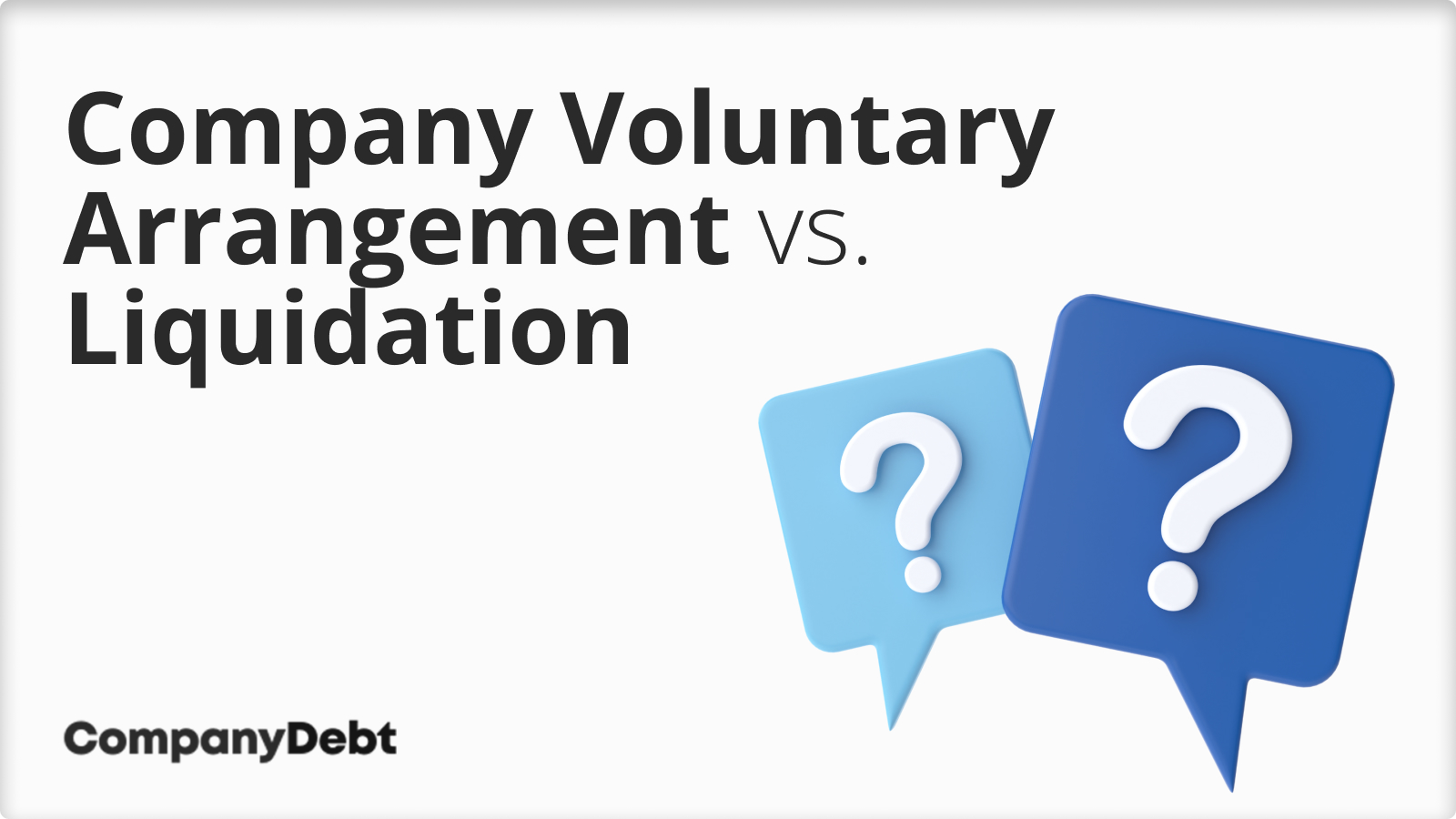
Company Voluntary Arrangement vs. Liquidation
What’s the difference between a CVA and a voluntary liquidation procedure (CVL), and which is the better choice for your company?
CVA[1]Trusted Source – GOV.UK – Company Voluntary Arrangements stands for company voluntary arrangement, which means a structured repayment plan with creditors, for a percentage of the total debt. This is a company rescue process, allowing the company to keep trading.
CVL[2]Trusted Source – GOV.UK – Creditors Voluntary Liquidation stands for creditors voluntary liquidation which is the term for a voluntary liquidation procedure; this means directors choose to liquidate to escape mounting creditor pressure.
We’ll explore the key differences between these two insolvency procedures below.

Key Differences Between CVA and Liquidation
CVAs and CVLs have fundamentally different aims and outcomes for your business.
Purpose and Outcome
A CVA is a rescue mechanism designed for companies with a viable core business despite current financial distress. The aim is to restructure debts and provide breathing space for recovery.
In contrast, liquidation is a terminal process appropriate when a company has no reasonable prospect of returning to profitability.
Legal Status
During a CVA, your company maintains its legal status as a going concern. Directors retain control, subject to the terms of the arrangement.
In liquidation, the company’s legal existence is being terminated. A licensed insolvency practitioner assumes control as a liquidator.
Creditor Implications
CVAs require the approval of 75% (by value) of unsecured creditors. This high threshold often necessitates significant compromises in the proposal.
Liquidation doesn’t require creditor approval, but typically results in lower returns for unsecured creditors.
Timeframe and Flexibility
A CVA usually spans 3-5 years, allowing for adjustments as circumstances change.
Liquidation is generally shorter (one year) but irreversible. Once initiated, there’s limited scope to alter course.
How a Company Voluntary Arrangement (CVA) Works
At its core, a CVA is a legally binding agreement between a company and its creditors. The process typically unfolds as follows:
- We prepare a proposal detailing how the company will restructure its debts.
- This proposal is put to a vote of creditors.
- If 75% (by value) of voting creditors approve, the CVA becomes binding on all unsecured creditors.
- The company then adheres to the agreed repayment plan, usually over 3-5 years.
Advantages of a CVA:
- Creditor pressure is alleviated, as legal actions are stayed.
- The company continues trading, preserving value and jobs.
- Directors retain control, unlike in administration.
- There’s potential for a partial debt write-off.
Potential challenges:
- Secured creditors are not bound by the CVA unless they agree.
- The company must generate sufficient cash flow to meet CVA payments.
- Failed CVAs can lead to more severe insolvency procedures.
It’s crucial to understand that a CVA is not a panacea. In my experience, successful CVAs require a robust underlying business and a genuine commitment from management to operational change.
Creditors Voluntary Liquidation
As an insolvency practitioner, I’ve overseen numerous liquidations, and I can assure you that while it signifies the end of a company, it can often be the most appropriate course of action in certain circumstances. The process is as follows:
- Directors resolve that the company is insolvent and cannot continue trading.
- Shareholders pass a resolution to wind up the company.
- A licensed insolvency practitioner is appointed as liquidator.
- The liquidator takes control, realising assets and distributing proceeds to creditors.
- The company is ultimately dissolved.
Advantages of Liquidation:
- It provides a clear endpoint, preventing further losses.
- Directors fulfil their legal duty to cease trading when insolvent.
- Employee claims are dealt with promptly via the Redundancy Payments Service.
- It can relieve the stress of trying to rescue an unviable business.
Consequences of Liquidation:
- The company ceases to exist once dissolved.
- Employees lose their jobs (although they may claim statutory redundancy).
- Directors’ conduct will be investigated, potentially leading to disqualification if misconduct is found.
- Creditors often receive only a fraction of what they’re owed.
While liquidation is not a decision to be taken lightly, it can be the most responsible course of action. It prevents further losses to creditors and can protect directors from allegations of wrongful trading.
In my professional experience, the key to a ‘successful’ liquidation is timing. Initiating the process before the company’s financial position deteriorates too far can lead to better outcomes for all stakeholders.
Factors to Consider When Choosing Between CVA and Liquidation
The choice between a CVA and liquidation hinges on several key factors, each of which requires careful consideration.
- Company Viability is paramount: A CVA is only appropriate if your company has a realistic chance of future profitability.
- Debt Levels and Types: High levels of secured debt can complicate matters, as secured creditors aren’t bound by a CVA unless they agree. In my experience, a debt-to-income ratio exceeding 3:1 often makes a CVA challenging to implement successfully.
- Creditor Relationships: The attitude of your major creditors is crucial. If key suppliers or HMRC are unwilling to support a CVA, it may be unworkable.
- Cash Flow Projections: A CVA requires consistent cash flow to meet both ongoing trading expenses and CVA contributions. Overly optimistic projections can lead to CVA failure, potentially leaving your company in a worse position.
- Management Commitment: Successful CVAs demand significant changes in business operations. As directors, you must be prepared for this. I’ve observed that CVAs often fail when management is reluctant to implement necessary operational changes.
In my professional opinion, the decision between a CVA and liquidation should never be rushed. It requires a thorough analysis of your company’s situation and frank discussions about its future prospects. Remember, the goal is not just to choose the option that keeps the company alive in the short term, but the one that best serves the interests of all stakeholders in the long run.
Not sure which is the best option?
If your business is experiencing financial difficulties and you are considering a Company Voluntary Arrangement or Insolvent Liquidation as a potential way out, we can help. Call 0800 074 6757 for no-obligation advice.
The primary sources for this article are listed below, including the relevant laws and Acts which provide their legal basis.
You can learn more about our standards for producing accurate, unbiased content in our editorial policy here.
- Trusted Source – GOV.UK – Company Voluntary Arrangements
- Trusted Source – GOV.UK – Creditors Voluntary Liquidation








